
AFTERMYTH OF A COLLISION CASE
One night in September 2003, a loaded Panamax vessel headed north trying to cross the east-westerly coastal traffic had a collision with a small chemical vessel. The weather is fine and clear. The small chemical vessel half submerged on the sea surface with ship bow pointing the sky. All four crew were able to get out on time, although had some wound more or less. The chemical vessel sunk very quickly after the collision. Luckily enough, the 400 tons chemical loaded is Xylene that is a highly evaporable substance. The impact to the ecosystem is minor. The relative low bunker quantity remained on the small chemical vessel won’t pose another threat to the fishery resources.
Before the collision, the Panamax vessel is steering course 008 with 19 Kts and the chemical vessel is steering 266 with 11.5 Kts. The Panamax vessel had detected the chemical vessel 6 N. M. away with CPA of 0.4 N.M.. The master had to take care of other east-westerly traffic with even less TCPA. Two minutes before the collision, master found the chemical vessel’s CPA had reduced to 0.2-0.3 N.M. and order STARBOARD 10. When the ship responded to the rudder and commenced the turning, the chemical ship had vanished into the blind area. Captain estimated the time interval needed to see the chemical vessel again on port bow. But the chemical vessel didn’t show up as captain’s expectation, captain order STARBOARD 20 to accelerate the turning rate. The chemical vessel still cannot see at port bow in this stage. Captain order HARD STARBOARD to clear the chemical vessel and the collision happened.
By all the useless actions of the starboard side turning, the captain assumed the chemical vessel should be hit by port side. From the statement of seaman rescued from the wreck, the chemical vessel had made the round turn to port side before the collision. The chemical vessel was hit at starboard side pump room which is located between third cargo hold and the engine room. The collision flooded the pump room and the engine room behind it causes the vessel sunken.
There are several issues of this case.
Ample sea room
Two ships occupy the same space at the same time is a collision. Keeping this in mind, we will put every leg of the course line very carefully and try to avoid crossing other ship’s course line as minimum as possible. The Panamax vessel’s course crossing the east-west traffic at full sea speed. The safe and comfortable distance of the coastal vessel is 0.5 N.M. comparing with the one N.M. of the ocean going vessel. The difference comes from the ship’s length. Coastal vessel has 50 Meters length over all with 6 times ship length for necessary advance to avoid collision. The safe distance is 50 M x 6 =300 M which is 0.15 N.M. When the traffic is heavy, all the coastal vessel proceed at 0.5 N.M. spacing or even less for traffic in reciprocal direction. The ocean going vessel need one N.M. to pass the coastal traffic comfortably.
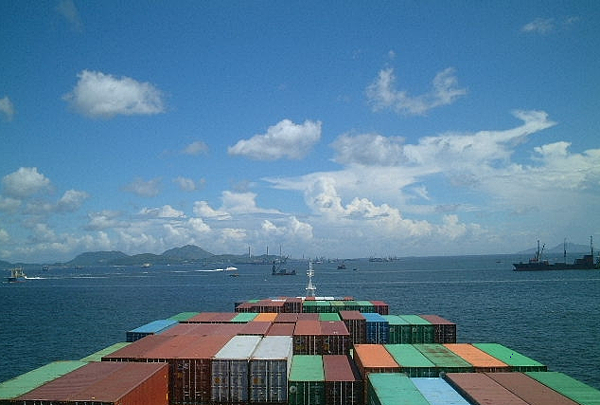
Course line crossing with other traffic
In this case, there is no comfort. The Panamax vessel’s course line is crossing every east-westerly traffic coastal lane at almost right angle, Ocean going vessel will have to have alter course to starboard to make ample sea room for stand on vessel. When the coastal vessels come in a bunch with 0.5 N.M. spacing, there is no safe distance left for captain to pass through directly. If the Panamax vessel cannot adjust the timing to arrive at these junction points with suitable spacing from east-westerly traffic, the solution from the route planning aspect will be roundabout.
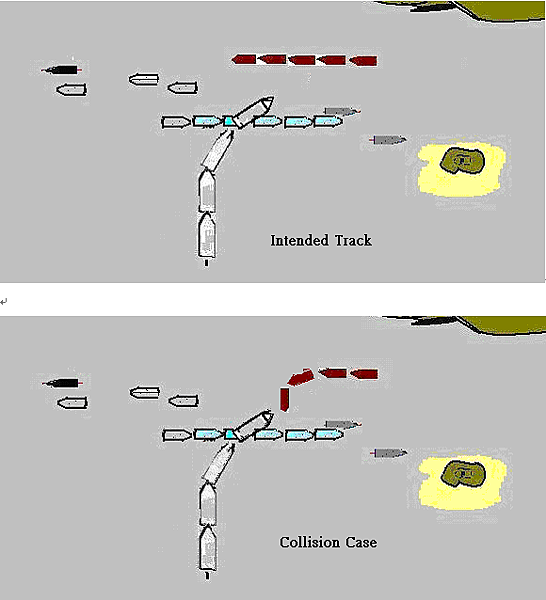
Possible area of collision
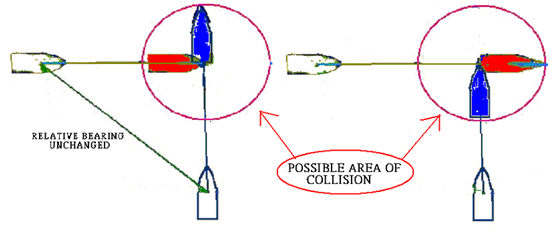
We need to get the feeling of own ship whole body movement, as the collision can be any point of the vessel. The space occupied by a vessel is its length over all (LOA) times it’s max. Breadth. There will be a collision space on the high sea, not the collision point only.
The possible area of collision is two ship length as shown on the drawing above. If the Panamax vessel can go round this area earlier, the collision with the brown vessel can be avoid. The problem is Panamax vessel had to stand on her course and speed to let the blue vessel to pass.
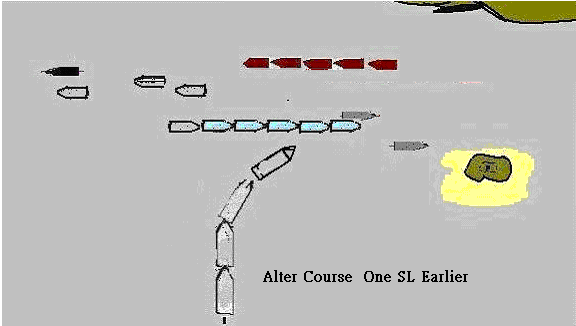
The drawing above show the possible scenario when the Panamax vessel took earlier action just one ship’s length ahead the original position. Panamax vessel cannot avoid the possible area of collision with the blue vessel.
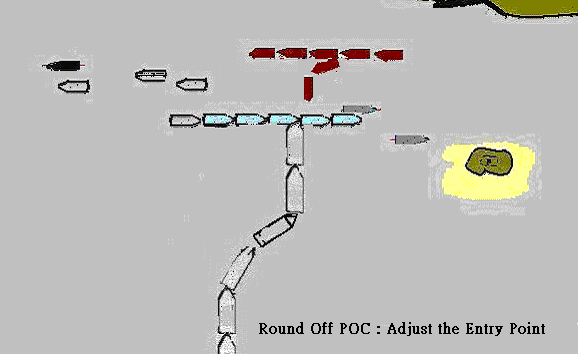
But, the situation may be ease off if the Panamax vessel can round off the possible area of collision even earlier, the collision risk will much more reduced. These early actions can adjust the suitable point to cross the heavy traffic. The rudder used to turn the vessel around off the POC can, more or less, reduce the original speed. However, this round off maneuvering is not the standard solution according to the COLREG. By the rule 10, vessel should proceed in the general direction of the traffic flow. In this case, it is east-westerly direction.
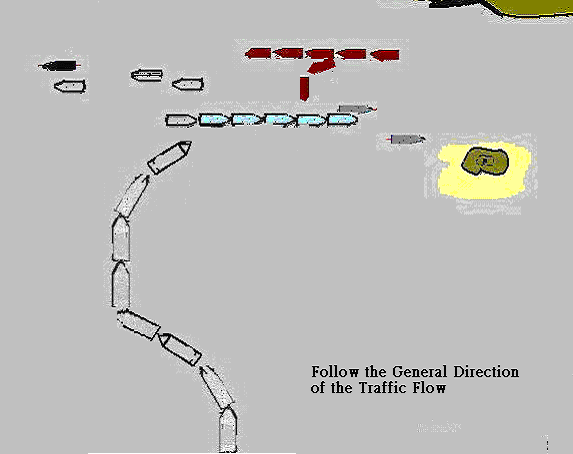
Panamax vessel circle outside of the general traffic route and change the approach direction. to the east-westerly traffic. This circling has two purposes. One is to adjust the crossing spot. The other is to change the approaching direction. The Panamax vessel cannot change course to starboard side directly, as it will block the blue vessel’s way and against the COLREG. By circling outside the traffic, the collision risk to the chemical vessel is diminished. However, the collision risk still cannot reduce. So, the Panamax vessel needs to go some extra miles to the east and find the suitable position to cross the east-westerly traffic. If the starboard side has not enough sea room, the Panamax vessel will have to change the approach direction to the east and wait for the right time to cross.
This cycling maneuvering is not a new idea, only now we know the specific purpose is to cross the traffic 0.4 N.M. portside from the original course line. If this circling has to be done, it is then better to do the circling 6 miles away when necessary collision data has been gathered. The early action can make sure own ship has enough sea room to adjust to the correct spot to cross. Even own ship has to change the approaching direction to east, the early action will not confuse the blue vessel .
Three stages of the turning characteristics
The turning characteristics of a particular vessel with different rudder angle been used. See the diagram below, then
We may divide the turning process into three stages:
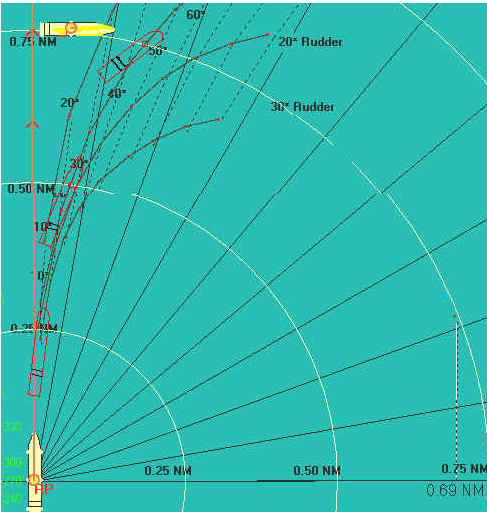
First stage: the rudder is put over, there will be a still time which seems the ship does not response at all then she will incline to the side where rudder is put over.
Second stage: ship's heading changed rapidly but her body still roughly follows the original track and ship flip over to the opposite side which rudder is put over.
Third stage: ship's heading changed in regulated rate and ship's body actually leaves the original course line. This is the stage ship can gain abeam distance from her original course line.
These stages had simplified deliberately for easy memory. ![]()
Now we can examine the turning curve closely. The four black curve line is the track of pivot point of vessel with 5,10,20,30 degrees rudder order been used. The straight line connected the red dot in black curve is the position of pivot point along the turning curve which heading had changed from original course. Each straight line is spaced with 10 degrees difference of heading.
This is a 285 meters long container vessel (Panamax size) and recent research show the ship's speed is irrelevant to the turning curve. (the ship's speed can only affect the time needed to finish the turn.) Each vessel's characteristics of maneuvering are different and captain have to use his own knowledge to evaluate the actual distance of these stages.
In this diagram, each stage is using 0.25 nm to represent. This will be too handy and may lose the real connection of vessel's characteristics. Nevertheless, the ship’s length over all is close related to the necessary advance to accomplish each stage. To simplify the discussion, we will use two ship's length to represent each stage of turning.
INITIAL TURNING WITHIN 2 SHIP'S LENGTH
In this stage, represented by the first red line vessel shape in the 0.25 nm range, the turning curve are almost identical regardless how much rudder we have used to change the heading. But, remember this is only the track of pivot point. The ship body is conducting a serious change from the bow to the stern. The ship bow will turn more inside the track of pivot point. The ship stern pushed by the rudder plate will always be leaved outside of the track of pivot point. The pivot point is the point neither moving inside nor moving outside when the ship body rotated by the rudder effect.
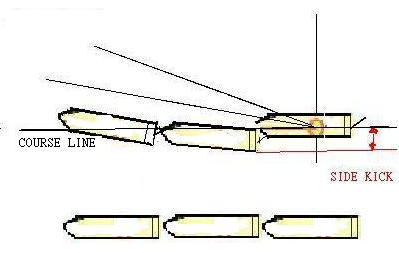
2 SL advance
When the ship responded to the rudder and commenced the turning, the chemical ship had vanished into the blind area. By the statement above, we know the vessel had advanced two SL and the chemical vessel already sail inside two SL from Panamax vessel’s bow. This coincides with the captain’s statement “take avoidance action two minutes before collision” which by our calculation is 4 SL. Once the collision target get into this distance, captain had no choice but continue the turning with more rudder angle. If the captain try to use the counter rudder to clear the target, it is surely in vain by the knowledge of 2 SL advance.
TURNING UP TO 4 SHIP'S LENGTH
Heading change will accelerate at this distance(2 to 4 ship's length) after initial stage. How many degrees it would turn depend on many factors like rudder angle used, rudder area, draft, trim, water depth, wind, current, bottom contour…,etc. All these factors will have some effect on the pressure field around the ship’s body which are not our intention to discuss here of the turning mechanism. The IMO turning ability requirement set out a standard to exclude those factors may affect and specify the sole use of the full speed and full rudder angle, ship should be able to complete a 90 degree turn within 4.5 ship's length advance.
After the first stage, the heading change is about one compass point (11.5 deg) as we see in last paragraph. With two more ship's length advance, the pivot point advance direction could change from 15 to 45 degree from her original course at this stage. And her drift angle which can be varied from 15 to 30 degree (drifting angle is the angel between her heading and the direction of pivot point advanced). Together, the ship heading change varied from 30 to 75 degree.
The whole ship's body movement measure from the pivot point still have the component to advance along the original course line and this component slowly decrease to zero when the pivot point advance direction change to 90 degrees (heading will be 90 degrees plus drift angle). The ship's stern is 3/4 ship's length abaft from its pivot point and still have not cleared the original course line in this stage.
Let's take a second look of the diagram above. The pivot point track is depending on how many rudder angle we have used. The pivot point position look like had take a ship's length transverse distance if the rudder order is hard starboard. If the rudder order we used is starboard ten, the pivot point will off the track only about half the ship's length. With the ship stern 3/4 abaft the pp, there still have 1/4 ship's length inside the original ship's course line.
4 SL Range
Once the small target already inside the 4 SL range, there is no cure by using the rudder alone. But, this 4 SL rule also apply to the small vessel. 4 SL for a Panamax vessel is 285 meters x 4 = 1140 meters. These 1140 meters is almost 23 SL for a 50 meters long vessel. That’s why when the Panamax vessel waiting anxiously, the chemical vessel may have conducted several swings and be hit at starboard midship section causing the sinking.
FINAL STAGE UP TO 6 SHIP'S LENGTH
Ship' can almost have enough transverse distance after 6 ship's length advance regardless how many rudder order (minimum 5 degree) been used. This is demonstrated on the turning curve drawing represented by the yellow vessel crossing the original course line. The main interest in this distance is what the ship’s track is through different rudder angle been used. Her heading may vary from 45 to 120 degree. The turning radius is varied from 4.5 to 9 ship’s length advance. The turning curve of 5 degree or 10 degree rudder angle been used is not fully illustrated on the drawing. The observation here is the transverse distance made out by 6 ship’s length advance is enough for avoiding the possible area of collision by using the rudder angle along.
For a 280 meter vessel, 6 ship's length is 280 x 6 = 1680 meter. Usually we take other ship distance from our own bridge, so 1680 meter plus some distance from the bridge to the bow is about one nautical mile. Some recommendation of collision avoidance state the minimum distance allowed to get close into other vessel in confined water is 7 ship's length. Based on the discussion above, this is quite reasonable.
Full rudder turning
In the heavy traffic, full rudder turning must use with caution. If the hard over rudder is used, it should not be used to make the full swing. It should only be used to initial the turning. But, the full rudder can only accelerate the turning rate after initial 2 SL advance. In the first 2 SL advance, the ship is still immobilize in her original course. Using the full rudder to avoid the smaller target is only useful when the target is within 4 to 6 ship’s length. After the ship response to the rudder, the hard over rudder should be reduced in time to avoid the ship lost control.
TCPA concept
The minimum distance to take the avoidance action is 7 SL. 7 SL is 1,995 meters(285 m x 7 = 1,995 m) By the speed of 19 Kts, 7 SL advance takes about 3.5 minutes(TCPA). Two minutes before the collision, master took avoidance action. If the collision target is also a Panamax vessel, this late action is already in fault.
The action distance is 1,172 meters (19 kts x 2 /60 x 1852 m = 1,172 m) which are 4 times ship’s length. Even for avoiding a smaller target, the 4 SL is not enough unless the ship use the hard over rudder. By this knowledge, the captain will not use only starboard ten rudder order at the first opportunity.
Keep the target in sight
If by using the rudder alone cannot avoid the collision, the Panamax vessel should stop the engine immediately. This can give Panamax vessel some extra time to assess the situation. But, it’s still cannot reduce the collision risk for the chemical vessel is still no where to see. This is another very important concept keep the target in sight all the time. Remember the steering rule of the COLREG is in sight of one another. Once the Panamax vessel lost visual contact with chemical vessel, the rightness of changing course to starboard side will no longer exist.
Change conning position to ship’s wing
The bearing change of target is only accelerating after the Panamax vessel had began the swing. From the statement of Panamax captain, the chemical vessel vanished into the blind area after the ship response to the rudder. Before the Panamax vessel response to the rudder, the bearing change is going very steady. Ship’s blind area won’t change every minute. The captain knows by heart when the chemical vessel will sail inside the blind area and he should change the conning position from the bridge to ship’s wing to keep the chemical vessel in sight.
Blind area as wide as the ship’s width
No matter how many meters ahead of the ship bow is block by any reason. If captain can check the visual contact from each side, the limitation of the blind area is only 32 meters wide as the Panamax ship’s width. The chemical vessel is 50 meter long. There is no escape from sighting unless the target is end to end with Panamax vessel which is not the initial case. If only the captain can spare some time to check the movement of chemical vessel from the shipside. The collision risk will much more reduce. . . .
limitation of the navigation aids
At the 6 N.M. range’s assessment, the CPA is 0.4 N.M. What if the Panamax vessel alter course 4 degree to the starboard side at 6 N.M. range? The transverse distance by this course change is 0.4 N.M.(![]() ). The Panamax captain’s statement “Two minutes before the collision, master found the chemical vessel’s CPA had reduced to 0.2-0.3 N.M.” The difference is due to the limitation of the navigation aids. The captain of Panamax vessel decides to take action should take the consideration of Possible Area of Collision which is 2 SL. Two ship’s length of Panamax vessel is 0.3 N.M.
). The Panamax captain’s statement “Two minutes before the collision, master found the chemical vessel’s CPA had reduced to 0.2-0.3 N.M.” The difference is due to the limitation of the navigation aids. The captain of Panamax vessel decides to take action should take the consideration of Possible Area of Collision which is 2 SL. Two ship’s length of Panamax vessel is 0.3 N.M.
The way to treat the coastal vessel
